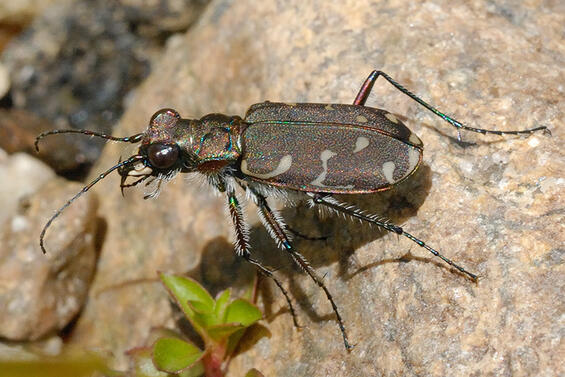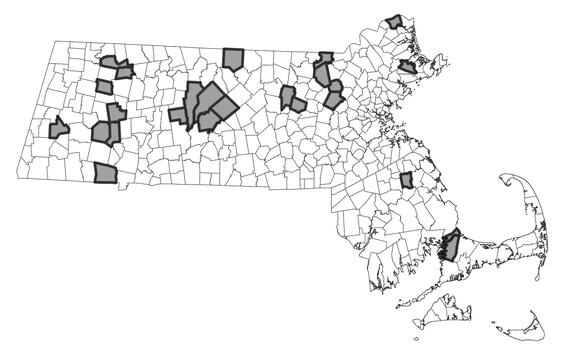- Scientific name: Cicindela duodecimguttata
- Species of Greatest Conservation Need (MA State Wildlife Action Plan)
- Special Concern (MA Endangered Species Act)
Description

Twelve-spotted tiger beetle (Cicindela duodecimguttata)
Tiger beetles are so named because of their “tiger-like” behavior of chasing down and capturing prey with their long mandibles. The twelve-spotted tiger beetle (Cicindela duodecimguttata) is 12-15 mm in length (0.5-0.6 in; Pearson et al. 2015). It is dark brown in color with a metallic sheen, the elytra (wing covers) marked with white maculations (spots and bands). The bronzed tiger beetle (Cicindela repanda) resembles the twelve-spotted tiger beetle, although the bronzed tiger beetle is smaller on average, a lighter shade of bronzed brown, and the elytra are marked with maculations that are more complete (the bands are less broken into spots). In addition, the twelve-spotted tiger beetle has a thorax that is trapezoidal in shape (wider anteriorly than posteriorly), while the thorax of the bronzed tiger beetle is cylindrical.
Life cycle and behavior

The twelve-spotted tiger beetle has a two-year life cycle. Adult beetles emerge in late summer, overwinter, and are active again in spring and early summer. In Massachusetts, mating and egg-laying occur in May and June. A few adults may survive into early July. Larvae develop through the first summer and autumn, overwinter, and continue development the following spring and summer, emerging as adults in August of the second year.
Distribution and abundance
The twelve-spotted tiger beetle is widely distributed across much of North America, from Newfoundland and Labrador south to Georgia, and west to Alberta and Texas (Pearson et al. 2015). In Massachusetts, the twelve-spotted tiger beetle occurs throughout most of the state, although it is absent from outer Cape Cod and the offshore islands.

Distribution in Massachusetts. 1999-2024. Based on records in the Natural Heritage Database.
Habitat
In Massachusetts, the twelve-spotted tiger beetle inhabits open areas in or near wetlands with sandy or silty soil, often river or stream banks or lake or pond shores. Adult beetles may be found in anthropogenic habitats such as old sand pits and sand roads, particularly those in or near wetlands. Larval habitat often consists of eroding stream or riverbanks (Knisley & Schultz 1997).
Healthy habitats are vital for supporting native wildlife and plants. Explore habitats and learn about conservation and restoration in Massachusetts.

Sandy river shoreline and sand bar, habitat for the twelve-spotted tiger beetle. Habitat managed by MassWildlife at Hop Brook WMA.
Threats
The twelve-spotted tiger beetle is threatened by alteration of natural hydrology in its wetland habitats, particularly flooding that maintains open river, stream, lake, and pond shore habitats by preventing vegetation overgrowth and by depositing sand and silt substrate. Other potential threats include invasion by exotic plants, eutrophication or other water pollution, river, stream, lake, or pond bank armoring, aerial insecticide spraying, and off-road vehicles. The effect of a warming climate may not be detrimental to the twelve-spotted tiger beetle in Massachusetts; its range extends south to Georgia, suggesting adaptation to warm temperatures. However, other effects of climate change, in particular changes in precipitation and hydrology, may be detrimental.
Conservation
Land protection and habitat management are the primary conservation needs of the twelve-spotted tiger beetle in Massachusetts. In particular, river and stream banks and lake and pond shores with sandy or silty soil should be conserved, restored, and managed to maintain habitat for this species and other species dependent on such habitats.
Survey and monitoring
The distribution of the twelve-spotted tiger beetle in Massachusetts is relatively well documented, though undocumented or newly colonized sites may yet be discovered. Known populations should be surveyed to document persistence at least once every 25 years; every 10 years is more desirable when practicable.
Management
Management of wetlands, in particular river and stream banks and lake and pondshores, benefits a diversity of species. For the twelve-spotted tiger beetle, sparsely vegetated shorelines with sandy or silty soil are of particular importance. Restoration and maintenance of natural hydrology and control of invasive exotic plants are of primary importance. Habitat condition should be monitored and management adapted as needed.
Research needs
The natural history and conservation needs of the twelve-spotted tiger beetle are relatively well known. However, the future effects of climate change on this species are unpredictable and should be documented.
References
Knisley, C.B. and T.D. Schultz. 1997. The Biology of tiger beetles and a Guide to the Species of the South Atlantic States. Virginia Museum of Natural History Special Publication Number 5. Virginia Museum of Natural History, Martinsville, Virginia. 210 pp.
Pearson, D.L., C.B. Knisley, D.P. Duran, and C.J. Kazilek. 2015. A Field Guide to the tiger beetles of the United States and Canada. Oxford University Press, New York, New York. 251 pp.
Contact
| Date published: | April 15, 2025 |
|---|